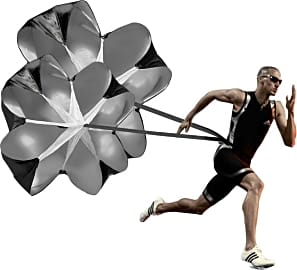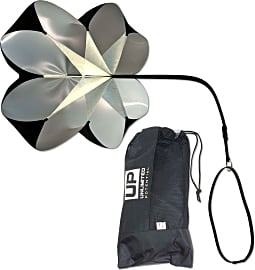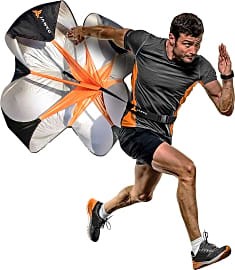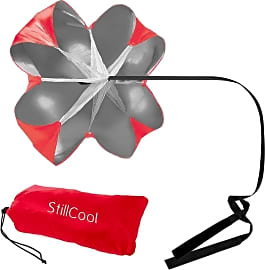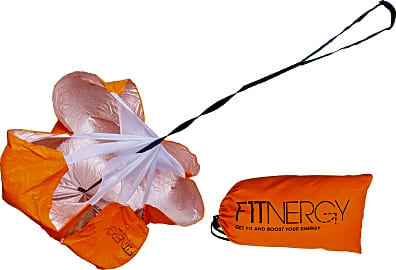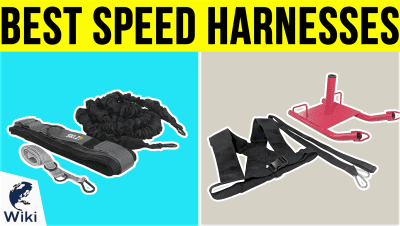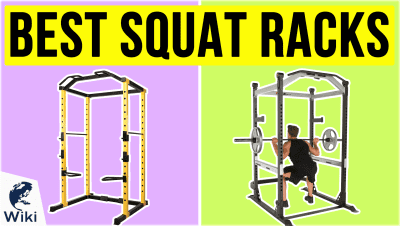The 7 Best Speed Chutes

This wiki has been updated 38 times since it was first published in January of 2016. What are you thinking? Isn't running hard enough on its own? Fair enough. If you really want to kick your training up a notch, try one of these speed chutes, which can help increase your strength and stamina. We've included models that offer a modest resistance for beginners through to a whopping 50 pounds for serious athletes in training. There is something here to fit every need and skill level. When users buy our independently chosen editorial recommendations, we may earn commissions to help fund the Wiki.
Editor's Notes
September 15, 2020:
Whether you are a professional athlete, training to make your high school track team, or simply trying to drop a few pounds, one of the speed chutes on this list can help. They are designed to provide progressive resistance, so the faster you run, the harder they will be. And, unlike many speed harnesses, these just have a single strap around the waist, so you can often release them at a second's notice when you want to put on those after burners and get a quick burst of speed to finish out a sprint.
While they are all, ostensibly, the same, there are a few very minor differences that can make certain options better suited to certain users and uses. For example, the Sklz Sprint Trainer, Jawku 360, and Unlimited Potential Parachute all feature sliding rings, so you can change directions and still encounter the same amount of resistance, without feeling like the chute is getting caught up and pulling from the wrong point on your body. This last one comes in two sizes too, so you can start off with a smaller one, and then move onto the larger one as you get into better shape.
Speaking of better shape, those who already know that a single unit might not provide them with enough of a challenge, or who simply want to plan for the future when they expect to be stronger and faster, can opt to buy the Kuyou Umbrella Trainer or Uber Soccer Double, both of which come with two chutes. That being said, it is worth mentioning that the ones included with the Uber Soccer Double are just 48 inches in diameter, so the Kuyou Umbrella Trainer is going to offer the most resistance of the two.
Most speed chutes come in a plan black and grey design, but if you prefer something a bit more vibrant, you'll want to consider the Jawku 360, StillCool ST-249701, and F1tnergy Sprint Trainer. The first has orange mesh, while on the latter two, the whole chute is a bright color.
July 31, 2019:
We'd be lying if we didn't tell that most speed chutes are pretty similar to one another. That being said, if you look closely enough you can find some minor differences that make a particular unit better suited to certain tasks or individuals. For example, the chutes on the Sklz Sprint Trainer and Unlimited Potential Parachute attach to a sliding ring, which allows the user to quickly change direction and still experience the same amount of resistance.
The Kuyou Umbrella Trainer and Uber Soccer Double both include two parachutes, making them ideal for those looking for a very extreme workout. On the opposite end of the spectrum, the Unlimited Potential Parachute comes in sizes as small as 40 inches, making it a good choice for use with teens and even younger children who aren't ready for a larger chute. You could also get a larger one for yourself and a small model for your kid, so you can get out on the field and train together. Most of the belts on the various models on our list can be adjusted to fit waists up to 42 inches, however, the F1tnergy Sprint Trainer fits waists up to 45 inches, making it the best choice for very heavy individuals.
While the majority of models feature quick-release buckles, we think some users may prefer the Velcro on the Uber Soccer Double and StillCool ST-249701, which makes it easier to release the chutes mid-sprint for an explosive burst of the speed at the end.
For those people who find that even the largest speed chutes aren't challenging enough, we recommend you take a look at weighted vests. These come in enough variety to suit the needs of the fittest individuals.
Benefits Of A Speed Chute
This makes it more likely to be beneficial to your performance, rather than just helping you to look good in your underwear.
If you've been around an athletic training facility in recent years, you may have seen people running around with open parachutes trailing behind them.
No, these are (probably) not failed skydivers — they're simply training with speed chutes.
Speed chutes are parachutes that you strap to your body before you start your sprint training. When you run, the chute fills up with air, creating drag. This challenges your muscles to work harder.
Training with a chute specifically builds fast-twitch muscle fibers, which is why you're more likely to see sprinters using them than marathon runners. This makes them a smart choice for other sports where quick bursts of speed are beneficial, like football, basketball, and soccer.
Not only that, but they build those fibers using sport-specific motions. That's a fancy way of saying that you're building the muscles that you'll actually use in the sport you play, rather than trying to mimic proper motion on a machine in the gym. This makes it more likely to be beneficial to your performance, rather than just helping you to look good in your underwear.
Chutes add progressive resistance, as well. The faster you run, the more drag you'll create, so the system inherently tailors the difficulty to your performance level. That allows your muscles to build up gradually, and reduces the risk that you'll overload them at any time.
Beyond that, it just feels good to exercise outside. You can get a lot of work done at the squat rack, but that gets old and repetitive awful quickly. Being outside will keep things fresh, and make you more likely to stick with your training.
A well-rounded workout involves more than just running with a speed chute, of course, but adding one to your routine can take your training to the next level, and you'll undoubtedly see the results when you get out on the field.
Even better, if you catch a nice draft, you might even get to fly above the stadium for a while.
Other Ways To Increase Your Speed
Some people think that speed is something you're born with, that you either have it or you don't. While that may be true at the extremes, there are certainly ways for you to take your zip to the next level.
The most important thing to remember is that the only way to run faster is by running faster. Got it? Good.
While there's a good chance no one will ever mistake you for Usain Bolt, that doesn't mean that you can't significantly improve your 40-yard dash time.
What we mean is, if you want to increase your sprinting speed, running a marathon isn't going to help. Distance running largely targets a completely different set of muscle fibers, and requires different running skills. The only reason to add distance running to a speed-building regimen is if you also want to build endurance, or if you have a few extra pounds that you think are slowing you down.
Instead, work in short bursts, using HIIT principles. Quick eruptions of speed are essential in just about any sport, and working out in short bursts will train your body to be turbo-charged whenever you need it to be.
Focus on your technique, as well. Keep your upper body stretched out but not rigid, keep your feet under your hips, and land on the mid-points of your feet. Remember to breathe, and pump your arms at 90-degree angles.
Keep speed in mind while lifting weights, as well. Explode through the positive portion of the lift, while going slowly on the way down. This trains your muscles to have explosive power, rather than incrementally powering through the motion.
Don't forget that it's a whole lot easier to be fast if you're not carrying a lot of extra weight. Anyone can get faster, regardless of body composition, but if you want to be fast, you'll need to have a lean body with decent muscle mass.
While there's a good chance no one will ever mistake you for Usain Bolt, that doesn't mean that you can't significantly improve your 40-yard dash time. All it takes is proper form, a quality training regimen, and a good friend running the stopwatch.
How Fast-Twitch Muscle Fibers Work
It seems like fast- and slow-twitch muscle fibers are something the scientists just came up with. After all, didn't there used to just be the one kind of muscle? Lousy millennials and their new muscles.
It turns out that there are actually three types of muscle fiber: slow-twitch, fast-twitch type IIa, and fast-twitch type IIb.
As a result, your body only calls on them when absolutely necessary.
Slow-twitch fibers are darker, because they have more myoglobin in them. Myoglobin is a protein that stores oxygen in cells, which is why slow-twitch fibers are better suited for endurance applications. However, they're not ideal for generating maximum force.
While there are two different types of fast-twitch fibers, they're basically identical except for their fuel source. These fibers come in a variety of sizes, with larger fibers being recruited by your body only when necessary — but these are the ones that can truly generate power.
The amount of force they generate depends on how many fibers are recruited. The more you work them — meaning, the more training you do — the larger they become, and they larger they are, the more might they can create.
However, while they can muster more power than slow-twitch fibers, the fast-twitch variety can't sustain that energy for long. As a result, your body only calls on them when absolutely necessary.
This is why working your fast-twitch fibers in short bursts is essential, and why trying to train them for extended periods of time is a fool's errand. Think of them like those bottles of whiskey you keep in your desk at work: something you only need in an emergency, but when you need them, you really need them.


